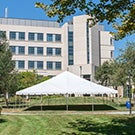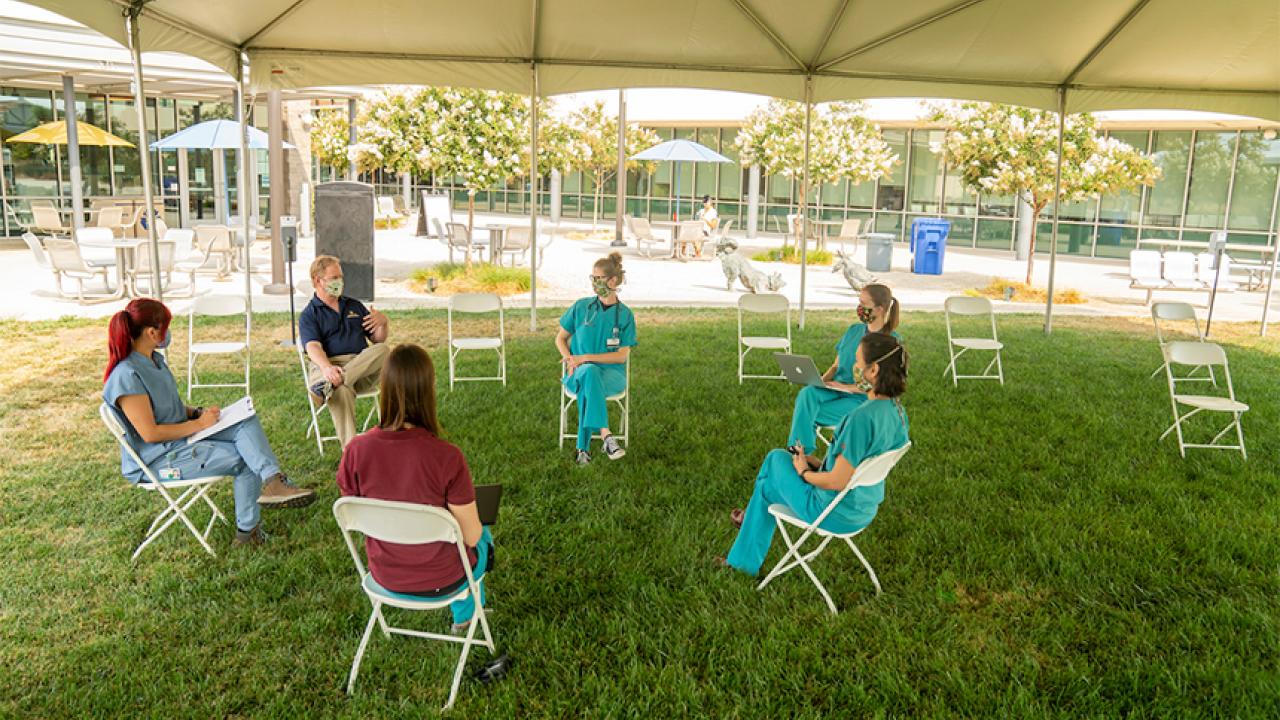Five tents have “come up like mushrooms” at the School of Veterinary Medicine, and more may populate the campus as it prepares to start the fall quarter and support physical distancing to fight the spread of COVID-19.
Monday (Aug. 17), plans and estimates for renting up to 15 additional tents for up to six months — at a cost of hundreds of thousands of dollars — were scheduled to be presented to Kelly Ratliff, vice chancellor of Finance, Operations and Administration.
TENTS AND OTHER RESOURCES
- If your unit wants to explore using a tent, first contact Lucas Griffith, director of campus planning.
- Coronavirus Information for the Campus
- Campus Ready website
The use of tents is in keeping with California’s guidance for institutions of higher education issued Aug. 7. As a way to implement distancing on campus, the guidance advises them to “consider use of nonclassroom space for instruction, including regular use of outdoor space, weather permitting.”
“Being outdoors provides a greater level of safety from COVID-19 because the large air volume dilutes the coronavirus concentration leading to decreased risk of transmission,” said Dean Blumberg, chief of pediatric infectious diseases at UC Davis Children’s Hospital. “There is greater risk of transmission inside a building where the volume of air is limited.”
Veterinary Medicine Dean Michael Lairmore said the school will be monitoring heat and air quality daily to determine if outdoor activity is allowed. The school has contingency plans to move activities indoors if necessary. The tents are not in use today (Aug. 18).
Universities across the country — including Baylor University in Waco, Texas; Rice University in Houston, Texas; Duke University in Durham, North Carolina; Syracuse University in New York; the University of Colorado in Boulder; and Eckerd College in St. Petersburg, Florida — are using tents for a variety of purposes including common space, dining, study, instruction, vocal and instrumental practice, and scheduled events.
Vice Chancellor Ratliff said she emailed a group of campus leaders about using tents to provide some shelter for physically distanced common and dining space, and Mary Croughan, provost and executive vice chancellor, suggested using them for some instruction, too. The idea was shared more broadly in a July 17 letter to instructors and graduate students and through a chancellor’s message to the campus community, which linked to the letter.
Up within week of decision
The School of Veterinary Medicine seized on the idea for instruction and general use space. The tents — ranging in size from 30 feet by 30 feet to 40 feet by 80 feet — went up within one week on Aug. 6 and 7 with the support of campus partners.
“Five tents came up like mushrooms,” said Lina Layiktez, director of Conference and Event Services, which is experienced in renting and using large tents for major campus events.
Lairmore agreed the project came together “rather rapidly” and added: “We really appreciate everyone’s collaboration.”
The school’s experience is expected to be helpful as the university considers deploying tents elsewhere with the start of fall quarter next month.

See the locations of the school’s tents
View the locations of the tents already up for the School of Veterinary Medicine on a map of COVID-19 resources. The map also includes outdoor hand hygiene stations on campus, and parks and hikes in the area.
Creating our own opportunities
Ratliff said she wants to make use of the resource and beauty of the campus. “We have lots of amazing open space,” she said.
“We hear so much about what we can’t do during the pandemic. It seems we need to create opportunities for what we can do.”
Lucas Griffith, director of campus planning, agreed that the physical campus lends itself well to this use. “We’re really fortunate to be entering the fall quarter with our campus,” he said, adding that the central part of the campus bordered by Highway 113 and Interstate 80 is, for example, four times the size of UC Berkeley.
When it comes to hosting tents, potential campus spaces need to do more than accommodate the footprint, anchoring and height of a tent. They also need be accessible for wheelchairs and away from the noise of construction, area buildings and passersby.
To identify sites, Griffith turned to digital campus maps that show all the trees, lawns, asphalt and underground utilities. After walking potential areas with others, he narrowed his list to 20 recommended sites (including the five for the veterinary school), and a few alternates.
Installation was ‘controlled chaos’
When it comes to tent installation, Layiktez of CES said PJ Kelly is “the ace in our back pocket.” The conference and event coordinator worked for local tent and rental suppliers in Dixon and Davis for 15 years before coming to UC Davis in 2006.
WI-FI COVERAGE
For teaching and learning and other general uses, the campus is aiming to provide wireless service to the tents. For Information and Educational technology, the challenge is to meet the technical demands of dozens of people using their devices in one area at the same time.
Steve Edington, senior engineer, said the department aims to make progress toward the longer term goal of expanding outdoor wi-fi coverage while meeting the immediate need. Plans include work to serve 18 of 20 sites; the other two are covered.
Fast-tracking the veterinary school’s tents, he drew tent plans, identified vendors, created estimates, negotiated contracts, rented furnishings and oversaw installation with help from other units. That involved closing a parking lot, moving bike racks, trimming tree branches, stopping irrigation and passing inspection by the campus fire marshal. As four tents went up Aug. 6, the school decided to add one more — and it was in place the following day.
Was it more demanding than running a three-ring circus? “It’s definitely controlled chaos,” Kelly said.
The tents, open on the sides, are adjacent to Scrubs Café, in a grassy area north of the Veterinary Medical Teaching Hospital, north of Vet Med 3B, and south of the Carlson Health Sciences Library (two tents).
The tents are equipped with folding chairs, some tables, hand hygiene stations, fire extinguishers and safety signage.
Finis Jones, director of custodian services for Facilities Management, said the tent furnishings will be cleaned three times a day using an electrostatic sprayer with a disinfectant and then wiped down. Custodial staff will also be setting up and collecting the 175 chairs for each day’s use.
From the Mondavi Center, the school has borrowed about 400 nonslip lap desks — earlier used for lectures in Jackson Hall — and provided them to students.
Clinical instruction demands more space
John Pascoe, executive associate dean for the School of Veterinary Medicine, helped oversee the tent project. He said existing school facilities are being used at only 25 percent capacity to allow for physical distancing, so the additional tent space extends that capacity. “It increases our flexibility,” he said.
While most classes will be taught remotely, Dean Lairmore said the school, like the nursing and medical schools, is required to hold in-person instruction for clinical programs. He added that the school must teach a prescribed curriculum and provide clinical experience to meet standards for accreditation of the school and the professional licensing of graduates.
A primary use of the tents will be for rounds, in which faculty, residents and students discuss the care of animal patients in groups of up to eight. “A lot of the learning takes place with the questions being asked,” Lairmore said. “The dynamics of teaching in rounds is not necessarily going to happen in a Zoom setting.”
Discussions, mentoring and other small group activities may also take to the tents. The school will post times for the tents’ scheduled use and cleaning so the community will know when the space is available for open use.
The total cost for the veterinary medicine tent project is about $90,000. This includes the use of the tents for four months, the cost of restoring damaged lawn or replacing it with other landscaping, and recharge from campus units for their services.
Students began clinical rotations in the Veterinary Medical Teaching Hospital in early June, and classes for the school's fall semester are underway. Lairmore said the students appear to be adapting easily to the idea of the tents being part of what helps their school carry on during the pandemic. “It’s not unusual for a veterinarian to be in a ‘field’ setting — veterinary students are used to that,” he said. “We’ve been impressed with their attitude.”
Tents in high demand
Tim Maguire, chief procurement officer with Supply Chain Management, said staff have worked quickly to identify vendors and produce estimates. “There’s a lot of demand in the market,” he said, adding that the campus is competing with restaurants for smaller tents and with area universities for larger ones.
Maguire said there are a few factors influencing the proposal to rent rather than buy tents. In addition to renting being a strategy to mitigate risk, he said, the campus does not use tents enough to get the return on the investment required to purchase them, and renting allows the campus to draw on the installation services of the vendor.
Ratliff said the campus may be able to include the tent project among COVID-19-related expenses for which the campus is applying for up to 75 percent reimbursement through the Federal Emergency Management Agency.
Three tents may be used to provide an option for physically distanced dining space to serve the Tercero and Segundo residential areas. Under current Yolo County public health orders, eating inside the dining commons is not permitted at this time. “We’re trying to make it a positive experience as much as possible,” said Kraig Brady, director of Dining Services.
As many as 10 of the other identified sites may be used for instruction and study space.
Ratliff said the next step is to develop guidelines for the tents’ scheduling and use to address issues like inclement weather.
